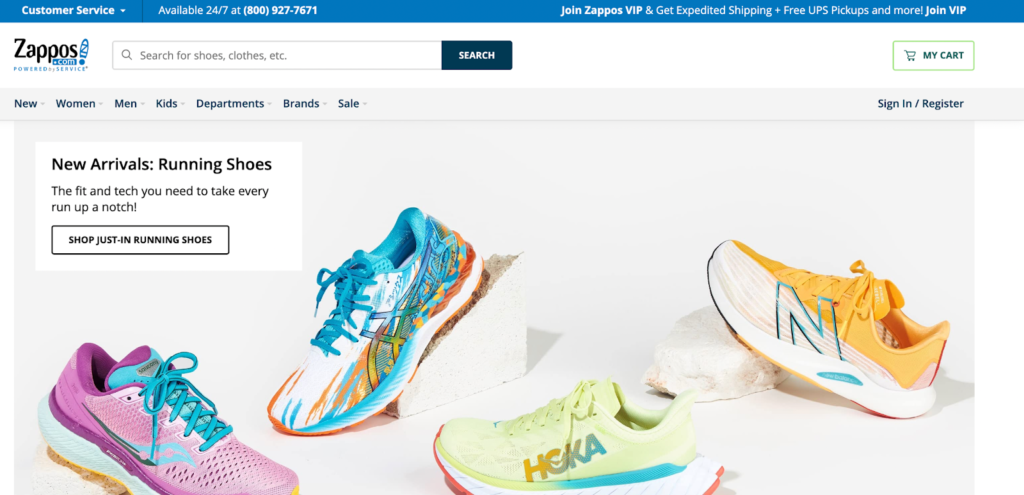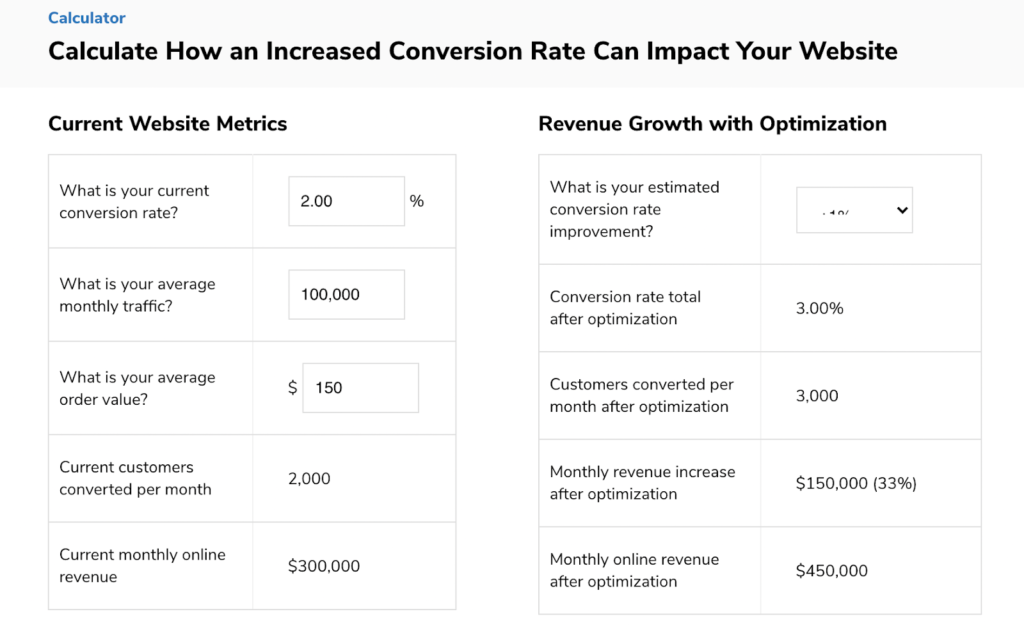
How to Build A Business Case For CRO
While research shows that CRO is a high priority for many, some decision makers still haven't taken the next step. We study why that is and provide some resources to help you make the case.
Are you convinced your company would benefit from an increased focus on conversion rate optimization (CRO), but the decision-maker at your brand somehow can’t see what you see?
We can help.
These figures are from the Conversion Rate Optimization (CRO) Report by Econsultancy:
- 90% of those who responded say CRO is ‘crucial’ or ‘important’ to digital marketing strategy
- 82% believe that concern about CRO within their company has grown in the past five years
- 49% of marketing professionals believe optimizing conversion rates is one of the top three requirements for producing growth at their company
Here’s the problem with that data: if most marketers agree CRO is high-priority, then why do we keep getting inquiries from frustrated employees who want to know how they can convince the boss to invest more deeply in conversion rate optimization?
Where’s the disconnect?
In this article, let’s talk about what holds decision-makers back from embracing aggressive CRO tactics, why that hesitance is unwarranted, and how you can help your boss realize what you already know: CRO isn’t just a good idea; in today’s hyper-competitive environment, conversion rate optimization is essential. We’ll cover how to:
- Draw the line between CRO and profit
- Sell the boss on the value of CRO strategy in 7 steps
- Use a free calculator to show potential ROI
Let’s get started.
Draw the line between CRO and profit
Much to the disappointment of those who suggest them, most good ideas never get a proper hearing. Fewer still actually end up being adopted.
Unlike a more familiar marketing technique such as AdWords, which has an obvious and direct connection to the bottom line, CRO can seem a bit abstract.
The idea that improving conversion rates by just a few percentage points can dramatically improve revenue seems far-fetched. And the reality is that CRO does cost time and money. Granted, it’s a small amount compared to the revenue it generates, but until you can demonstrate that revenue, executives will only be aware of the costs. Getting leadership on board requires that you demonstrate its value.
You need to help them see the specific and direct connection between increased conversion rates and an ever-increasing bottom line. You need to educate them on the many ways CRO can have a positive impact at every point of the funnel. CRO tends to be neglected and not trusted. A survey noted:
- 41% of respondents say there is no one directly accountable for conversion optimization at their company.
- 26% of respondents meet with their optimization team to discuss CRO “only when necessary”. And 23% of those who have a CRO team don’t meet more than biweekly.
- The majority of respondents run fewer than 5 tests a month. 43% only run 1-2 tests per month.
There is good news, however. CRO speaks the language of the CFO. In the end, CRO is about metrics, testing, and hard data, all leading to a boost in the bottom line and a measurable return on investment (ROI). It’s not about guesswork, “visionary” branding, or the current hottest trend in marketing.
The CFO might not understand iterative testing, but they certainly understand increasing revenue with minimal costs and a high ROI. This leads to the question: how do you clearly demonstrate the value of optimization to high-level executives? And, perhaps more importantly, how do you secure an increase in yourCRO budget (or a CRO budget at all)?
Sell the boss on the value of conversion rate optimization
To get your ideas heard and appreciated, you need to sell the boss, and it all begins with knowing exactly who ‘the boss’ is. Who has the authority to flip the right switch?
1. Find out who the decision-maker is and build a relationship with them
It’s all too easy to take your ideas to the person you feel most comfortable speaking with – the one you think most likely to express agreement and support.
That can be a good way to gain support for implementing a rigorous CRO strategy, it may even be the chain-of-command path you need to take to get an audience with the boss, but your mission won’t be successful until you have buy-in from the person or persons with the ability to say “Yes.”
In some cases, the decision will need to be approved by a group of people. Most of the time, though, getting more emphasis on CRO is something one person can authorize.
You’ll need to consider the situation carefully. Don’t fall into the trap of giving your presentation to someone who doesn’t have the authority to give the go-ahead, but agrees to make the case up the ladder for you.
Your job here is to hold back on giving away the farm. Find out who has the power to decide, then determine how you can get in front of that person or group of people with your proposal. Save the brunt of your arguments for that event.
2. Understand their perspective
You need to understand why people are hesitant about increasing the CRO budget. Before you launch into an elaborate PowerPoint presentation or well-constructed argument, take time to listen. Ask them why they’re concerned with investing in CRO strategy.
Kevin Daum puts it this way:
“People who know how to persuade also know that just pushing your own argument will get you nowhere. They certainly are able to articulate their position in a convincing way, but that is only half the equation. They are actively listening when in persuasion mode.“
First, they are listening to assess how receptive you are to their point of view. Second, they are listening for your specific objections, which they know they’ll have to resolve. Last, they are listening for moments of agreement so they can capitalize on consensus.
Amazingly persuasive people are constantly listening to you and not themselves. They already know what they are saying. You can’t persuade effectively if you don’t know the other side of the argument. Only after you understand their true objections can you present persuasive arguments. Frankly, most opposition isn’t due to hostility but ignorance.
Executives simply can’t see how CRO will help the company achieve its core objectives. It suffers from the same problem social media marketing did in the early days, when most businesses thought it was a flash in the pan that would soon pass.
Additionally, there is often a subjective ingrained opposition to CRO. Some people may have heard stories of investing money in CRO and getting very little in return. Or they may have been burned in the past by other business trends and suspect that this falls into a similar category. Or it simply could be an ego issue. People don’t like to admit that they don’t understand something.
3. Identify the most pressing problems CRO will help solve
Once you’ve taken the time to truly listen and understand, you can begin dispelling the wrong assumptions and confusion regarding CRO. A simple way to dispel the confusion is to demonstrate the current methods used for improving conversions, how effective they are, and explain the strategy for improvement. Because almost all these methods deal explicitly with data, they’re very difficult to argue with.
You can show how A/B testing is not about intuition or guesses, but about understanding your customer through user testing, creating hypotheses, and then doing real tests to determine their validity. You can explain that user testing allows you to clearly see how users are navigating your site and then eliminate the problems that prevent them from purchasing. If you have implemented previous tests (and you should have), show the results of those tests and how scaling the tests could dramatically improve the bottom line.

Don’t take it for granted that your prospect sees the problems as clearly as you see them. If things are running along smoothly, the tendency will be to maintain that pace, not to disrupt it.
There are two ends to the stick you’ll be holding. One end will describe the potential increase in sales revenue from a boost in conversions. The second will describe the competition’s daily effort to eat your lunch. Increased conversion rates are fuel to the engine that keeps your business running.
Most ecommerce websites, for instance, show alarming cart abandonment rates. What if CRO could get more prospects to become buyers for your B2B business? Or how is the opt-in rate to your mailing list? Would getting more and better qualified prospects be valuable to your bottom line?
It’s impossible to relax and float along the stream to profits. Your company must work aggressively to stay in the race. Either that, or eat the dust of those who understand the urgency of the times.
Lay out the problem(s) you’ve identified, then show how the conversion rate optimization strategy you’re proposing can help solve them.
What if you had a tool that would allow you to plug in three common data points, then show the revenue growth that would result as conversion rate varies? Would that be helpful?
That tool is yours to use freely. If you can’t wait to get on board,check out our optimization ROI calculator.
4. Emphasize the value in improving customer experience
It’s important for the leadership to understand that CRO is not exclusively about revenue, although that’s certainly at the heart of it. It’s also about dramatically improving the user experience. We’ve all experienced the frustration of trying to navigate a clunky site that makes it almost impossible to purchase. That experience almost always leads to us never visiting again. CRO eliminates that experience. How?
- Improving customer retention. When customers have an easy, user-friendly shopping experience, they come back again and again.
- Reduced customer service workload. A smoother customer experience always leads to fewer frustrated customers and customer support calls. This, in turn, reduces customer service costs.
- Business-wide improvements. Unlike many improvements, which only affect a particular department, CRO results in business-wide improvements. For example, a new shipping system improves the order fulfillment side of the business but doesn’t do a whole lot for sales. CRO, on the other hand, improves customer service, sales, marketing, and a host of other areas.
- Increased exposure. Better customer experiences inevitably lead to more word of mouth marketing, exposure, and brand visibility. Zappos is a prime example of this. Their epic tales of customer service have made the company a legend and attracted many customers burned out on traditional shopping.

- Improve acquisition. More word-of-mouth marketing means more customers, more revenue, and a lower customer acquisition cost. And CRO will help ensure you get more ROI from your traffic generation spend.
- Reduced customer churn. Churn is the bane of ecommerce companies. Acquiring customers costs enough as it is, and when you add retention costs on top of this, it takes a big bite out of the bottom line. CRO directly minimizes churn by improving user experience.
5. Use case studies or competitive analysis to support your case
There’s a really good chance that your competition is implementing CRO strategy, and if you don’t keep pace, you’ll fall behind. This is one of the deepest fears of C-level executives, and by tapping into this fear you can demonstrate the value of CRO. If, by some chance, your competition is not using CRO, you can present it as a massive opportunity to overtake the competition and cut into their market share. Three simple ways to demonstrate what the competition is doing:
- Do a competitive analysis. Evaluate their growth and, if possible, tie that into specific optimizations they’ve made.
- Analyze companies that your leadership monitors, admires, and respects. If they see a highly respectable company using CRO, it can demonstrate the legitimacy of the practice.
- Use a tool like Datanyze to see if the competition has a CRO tool installed on their site
Showing case studies from successful companies can also be a hugely effective tool. It allows executives to have a clear before and after picture when it comes to CRO investment. For example:
- L’Axelle made a few small tweaks to the copy on their add to cart buttons and saw a 93% increase in conversions.
- 37signals made some small design changes to their homepage and saw a 102.5% increase in signups.
- Nature Air changed the position of CTA content and saw a 591% increase in conversions.
Case studies like these show that CRO isn’t a marketing technique used by a few outlier businesses. Rather, it’s being successfully implemented in many companies across numerous industries. If all of these fail, play the Amazon trump card. Amazon, along with many other massively successful companies (Facebook, Google, Apple, etc.) use CRO to constantly improve and optimize.
As Lela Draganic notes:
“It’s not a secret that some of the biggest and most famous companies base their growth on CRO. They invest heavily in it and depend on it when making decisions about future innovations and strategies. Booking.com, Facebook, Amazon, Google – all the heavy hitters do it and it’s an accepted part of their everyday business. You can also find examples of much smaller companies that embraced CRO and swear by it. It has worked wonders for them too, even if they’re just a fraction of the size of those giant companies. The results of these companies speak for themselves.“
6. Be ready to answer common CRO objections
You’ll need to have done your homework thoroughly. You must know which objections are most likely to come up, and you must have a plan to counter them. You don’t want to simply neutralize objections, you want to find ways to leverage them to your advantage.
Jon MacDonald and Ryan Garrow did a deep dive into common CRO objections on their podcast, Drive & Convert. Listen to it before your meeting to hear some common objections and how to reply.
“The investment level that is needed to do CRO right can often be a challenge. And I think that this comes down to folks just not calculating the return on investment. It’s that plain and simple. If you look at this from a return on investment, there is nothing else in marketing that can net you such a high return on investment.” – Jon MacDonald
You will need to learn all you can about the decision maker’s current attitude towards CRO and marketing strategy in order to be well-prepared.
Here are a few examples of common objections to address.
- Your conversion rate optimization plan will require money not currently in the budget. – This is a stand-by objection to any idea requiring capital outlay. You must know why CRO is a wise investment. The tool we’ll give you will go a long way towards helping you clearly show the potential CRO has to earn considerably more money than it costs.
Ultimately, it will be difficult to convince the leadership if you don’t bring a clear implementation plan (including budget) to the table. This plan should contain a clear picture of your average order as well as the average customer lifetime value. Once you have these numbers, you can identify good and bad ROI investments, as well as determine if a CRO investment can move the needle on these metrics. A clear implementation plans helps leadership understand:
- The opportunities available
- The specific steps you’ll take to exploit those opportunities
- How long it will take
- The cost of the investment
- The expected ROI of the investment
- Your conversion rate optimization plan will require staff we don’t have. – CRO is more than a set of tactics to employ. CRO is an attitude. It is a culture of success. Your presentation must not only show potential gains to the bottom line, but it must list all extra expenses needed to realize those gains. Show how the load can be distributed and how you can step in to help spearhead the project. Once the CRO mindset catches on, the entire team will start seeing opportunities to push the conversion rate up just a little bit more.
- Your conversion rate optimization plan will require too much complexity. – All companies are overloaded with data. Since CRO is steeped in the collection, interpretation, and utilization of data, it’s easy to equate your CRO suggestions as additions to the headache. Your job is to show the data necessary for input is already available or can easily be obtained, and that the interpretation/utilization of the data will get a huge assist from automation. All that’s really needed is a champion (you) to oversee the implementation.
The beauty of CRO is that you don’t need to totally revamp your business strategy in order to implement it effectively. It doesn’t require a rebrand, a strategic shift, or a dramatic pivot. It can slot in nicely with your company’s existing strategies. The leadership will probably have reservations if you suggest sweeping changes. CRO allows you to suggest small, incremental ways that things can be improved. Some straight forward ways to do this:
Contrast areas where success has been seen against areas that still need to be optimized. Assuming you’ve optimized some areas already, you can show them how this has led to success and how the same strategies can be implemented in other areas of the business.
7. Connect the dots between CRO and profit, again
Unlike paid media, in which you are spending money to get more traffic to your site, CRO works with owned media, your website. The benefit of CRO is that you’re simply improving the effectiveness of the traffic already coming to your site. In contrast to buying traffic, CRO costs won’t rise in parallel with your sales. This, in and of itself, is an advantage over the widely accepted practice of buying traffic.
In fact, many of the changes that CRO can bring can actually reduce costs elsewhere. If you can demonstrate that even a small change in conversion rates can have a substantial impact on revenue gain, you’re much more likely to convince leadership of the value of CRO. For example, if you have 100,000 visitors coming to your site each month and 1.5% are purchasing a $150 item, that’s about $225,000 in monthly revenue. If you can increase your conversion rate 33% up to 2%, that’s an additional $75,000 each month.
Your CEO may scoff at a 33% increase, but he’ll change his tune when he sees the bottom line results. And, when you tell him that the costs of that increase are sustained and you don’t need to buy more traffic, it makes an even stronger case. This is where sample A/B tests can be so powerful. You can clearly show the undeniable effects of CRO. You start with your existing data, then propose a hypothetical scenario.
For example: “Let’s say we change the layout of the product page in this way, and that leads to a 2% increase in conversions. That will double our revenue! Now imagine if we saw those kinds of results on a regular basis.” Numbers speak much louder than jargon and buzzwords. Leadership ultimately thinks in terms of ROI, profit/loss, and market share.
CRO is a powerful way to increase revenue without a significant increase in costs. The math for CRO is difficult to refute. It’s a straightforward more profits/fewer costs equation. If CRO will multiply profits, why hesitate to use them as an investment?
Use this CRO calculator to support your case
Here’s a tool to make your life easier:the CRO Calculator.

This isn’t a marketing gamble. Rather, it’s a strategic, data-driven plan that has a high chance of success. It’s all about generating a positive return on investment.
That’s what many C-level executives fail to understand. Your job is to help them see that CRO is not a marketing trend based on anecdotal evidence, like the recent Pokemon Go trend in which businesses were claiming it drove more foot traffic to their locations. Optimization is about data, hypotheses, testing, and conclusions. It’s probably the closest thing to the scientific method in the business world.
Your chances of getting an increase in your CRO budget are much higher if you can highlight the bottom-line results. If you want to estimate the ROI you would get based on your CRO budget, use our free ROI calculator.

About the Author
Jon MacDonald
Jon MacDonald is founder and President of The Good, a conversion rate optimization firm that has achieved results for some of the largest online brands including Adobe, Nike, Xerox, Verizon, Intel and more. Jon regularly contributes content on conversion optimization to publications like Entrepreneur and Inc. He knows how to get visitors to take action.